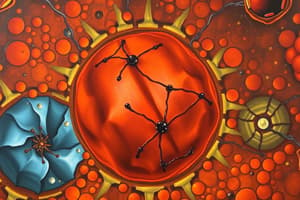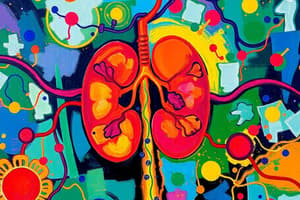Podcast
Questions and Answers
What is the main function of glycogen in the body?
What is the main function of glycogen in the body?
- To be a secondary storage form of fatty acids
- To store excess glucose for energy supply (correct)
- To act as a structural component in cell membranes
- To serve as a direct energy source for all bodily functions
Excess glycogen accumulation in the liver can be associated with which of the following conditions?
Excess glycogen accumulation in the liver can be associated with which of the following conditions?
- Protein malnutrition increasing glycogen depletion
- Diabetes mellitus affecting glucose metabolism (correct)
- Excess insulin production leading to fat storage
- Hypoglycemia due to decreased glucose production
Which of the following accurately describes endogenous pigments?
Which of the following accurately describes endogenous pigments?
- Only derived from dietary sources and not produced by the body
- Pigments that are always harmful to cellular function
- Pigments synthesized within the body and may be normal constituents (correct)
- Colored substances synthesized externally, not within the body
What color does glycogen typically stain when using a periodic acid Schiff (PAS) stain?
What color does glycogen typically stain when using a periodic acid Schiff (PAS) stain?
Glycogen storage diseases primarily involve abnormalities in what?
Glycogen storage diseases primarily involve abnormalities in what?
Study Notes
Glycogen Accumulation
- Glucose is the primary fuel source for cells.
- Excess glucose is stored as glycogen in the liver and muscles.
- Glycogen is stored within the cytoplasm of cells.
- Abnormal glucose or glycogen metabolism can cause excessive intracellular glycogen deposits.
- Glycogen appears as clear vacuoles within the cell cytoplasm.
- Glycogen stains pink/violet with periodic acid Schiff (PAS) stain.
- Glycogen accumulation is seen in diabetes mellitus due to impaired glucose metabolism.
- In diabetes mellitus, glycogen accumulates in the kidney (proximal convoluted tubules), liver, pancreas (β cells of the islets of Langerhans), and heart muscle cells.
- Glycogen storage diseases are a group of genetic disorders characterized by abnormal glycogen metabolism and accumulation in the liver, muscle, and other tissues.
Pigment Accumulation
- Pigments are colored substances.
- Pigments can be endogenous (synthesized within the body) or exogenous (from external sources).
- Endogenous pigments can be normal constituents of cells (e.g., melanin) or abnormal.
- Examples of endogenous pigments include:
- Lipofuscin
- Melanin
Studying That Suits You
Use AI to generate personalized quizzes and flashcards to suit your learning preferences.
Description
This quiz focuses on the processes of glycogen and pigment accumulation within cells, exploring their metabolism, storage, and implications in diseases such as diabetes mellitus. Learn how abnormal glucose metabolism leads to glycogen deposits and the role of pigments in cellular function. Test your understanding of these critical cellular phenomena.




